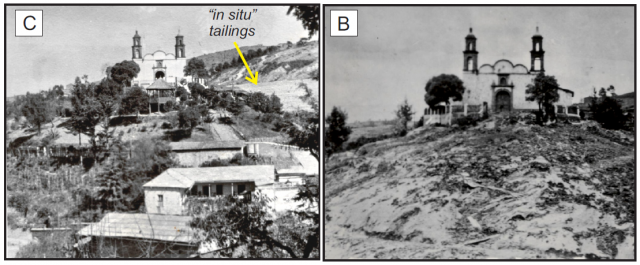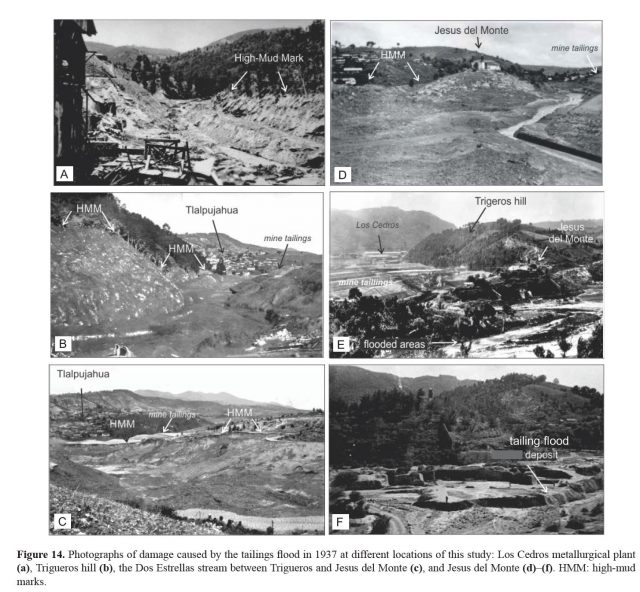27 December 2018
Tlalpujahua, Mexico: the Christmas town with a tragic landslide history
Posted by Dave Petley
Tlalpujahua, Mexico: the Christmas town with a tragic landslide history
Mexico News Daily has an interesting article about the town of Tlalpujahua in Michoacán, Mexico. This town is renowned for the manufacture of Christmas ornaments:
“Tlalpujahua has a new form of gold. It comes in the shape of locally-made glass Christmas tree ornaments. Nowadays, visitors flock to the town to buy these artisan creations for their Christmas tree. For anyone who wishes it could be Christmas every day, Tlalpujahua is the place for you since these ornaments are found in stores throughout the year.”
But this success is built on tragedy. From about 1900 to 1937 Tlalpujahua was home to a highly productive gold mine. Then, on 27th May 1937, a catastrophic tailings landslide buried about a third of the town, killing at least 300 people. This pair of images shows the scale of the disaster:-

Before (left) and after (right) images of El Carmen church in Tlalpujahua. Note the houses on the lower slope before the failure, and the tailings on the hillslope behind. Images from Macías et al. (2015).
The landslide is described in a paper published a few years ago in the journal NHESS (Macías et al. 2015), which is open access (i.e. available for free download). This paper provides a detailed account and post-event investigation of this landslide. The landslide was triggered by a typical tailings dam failure, similar to recent events in Brazil, China and Australia, amongst many others, at a dump known as Los Cedros. About 16 million tonnes of waste were released to form a catastrophic debris flow, which travelled at speeds in the range of 20–25 m per second down the Dos Estrellas and Tlalpujahua channels, striking the town in the vicinty of El Carmen church (about 2.5 km downstream from the dam), burying them to a typical depth of 2 metres.
Macías et al. (2015) include this set of images of the aftermath of the debris flow at Tlalpujahua:-

A montage of views of the aftermath of the Tlalpujahua tailings landslide in Mexico in 1937. Images from Macías et al. (2015).
.
The failure of the tailings dam at Tlalpujahua was triggered by a period of intense rainfall. The initiation of the failure began on 26th May, when a section of the dam failed. Macías et al. (2015) describe this as follows:-
“On 26 May at 17:30 [local time] a 4 tonne block detached from the lower part of the impoundment, leaving a 30m wide hole. After this small landslide, mine dam caretakers warned villagers downstream to leave their homes because a large landslide may occur. Unfortunately, only a few paid any attention and this warning went unheeded. That same day, at around 23:20, another block detached from the impoundment, flooding the road to the Los Cedros metallurgical plant and the Juarez bridge. Intense rain accompanied by lightning persisted throughout the night.”
The failure occurred the following day:
“At around 05:20 on 27 May, a large block (6 to 8 tonnes) of tailings collapsed, producing a din followed after a few seconds by a powerful air blast – which we interpreted as an air pressure wave – that flattened trees, fences, and houses. Eyewitnesses described the flood as a muddy to sandy, fetid mass that rapidly channeled into, and filled, the stream. The ensuing flood rushed downstream … Inhabitants felt the ground shaking caused by the flood impact. As the flood crashed against Trigueros hill, it diverted into an eastern upstream flood and a western downstream flood. The upstream flood flowed moved eastward a few hundred meters to the Los Cedros metallurgical plant, and then it waned and stopped. Instead the downstream flood rapidly transformed into a huge catastrophic wave at least 30 m in depth that swept towards the village of Tlalpujahua and San Jesus del Monte hill, which was crowned by a church. Between Los Cedros metallurgical plant and San Jesus del Monte hill at least eight neighborhoods were completely destroyed.”
…
“The huge rushing flood uprooted everything along its path as houses, trees, electrical poles, people, and animals were swept away. The electrical poles and wires downed by the flood generated short circuits, producing explosions, lightning, and gases. The explosions burned trees everywhere, initiating short-lived fires. During all this chaos, the windy storm persisted. Some people climbed the hills of Trigueros and San Jesus del Monte to save themselves. Survivors who reached these, or lived at higher elevations, described that the flood had the appearance of a fetid lake moving downstream … Eyewitnesses observed roofs, logs, furniture, and plants floating in the flood.”
This landslide, over 80 years ago, sounds very familiar. The tailings were located in an inappropriate site, upstream of population. The dam was improperly engineered. Early indications that a failure might occur were ignored or suppressed. Warnings were issued, but not systematically, so they were mostly ignored. And, finally, a period of heavy rainfall triggered collapse, with disastrous consequences.
This failure shows that the management of some tailings sites has been unacceptably poor for almost a century, and probably more. As I have noted previously on many occasions, we would not tolerate the level of catastrophic failure seen in tailings dams in any other geotechnical setting.
Reference
Macías, J. L., Corona-Chávez, P., Sanchéz-Núñez, J. M., Martínez-Medina, M., Garduño-Monroy, V. H., Capra, L., García-Tenorio, F., and Cisneros-Máximo, G. 2015. The 27 May 1937 catastrophic flow failure of gold tailings at Tlalpujahua, Michoacán, Mexico. Natural Hazards and Earth System Science, 15, 1069-1085, https://doi.org/10.5194/nhess-15-1069-2015.


 Dave Petley is the Vice-Chancellor of the University of Hull in the United Kingdom. His blog provides commentary and analysis of landslide events occurring worldwide, including the landslides themselves, latest research, and conferences and meetings.
Dave Petley is the Vice-Chancellor of the University of Hull in the United Kingdom. His blog provides commentary and analysis of landslide events occurring worldwide, including the landslides themselves, latest research, and conferences and meetings.